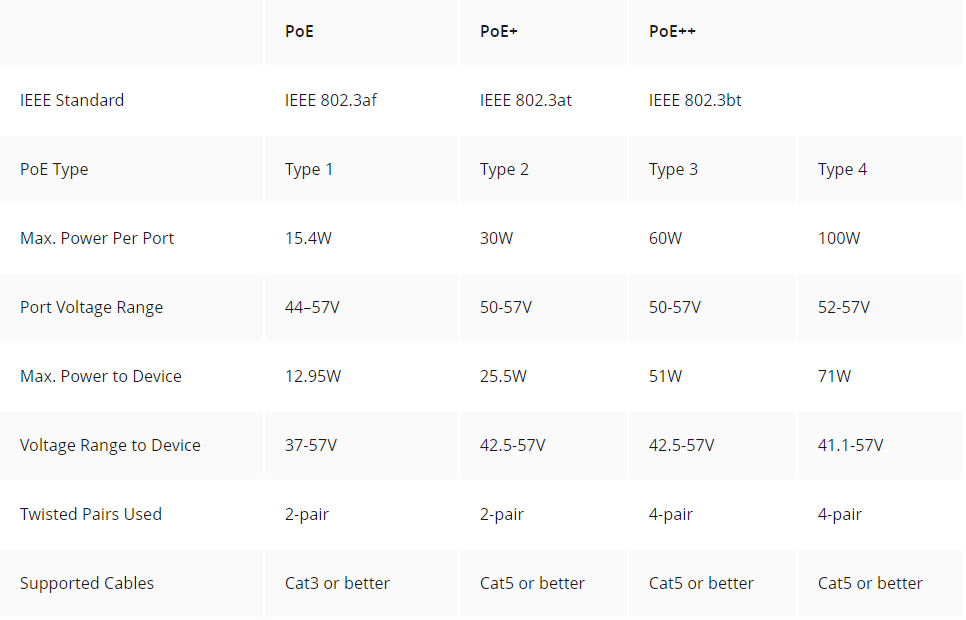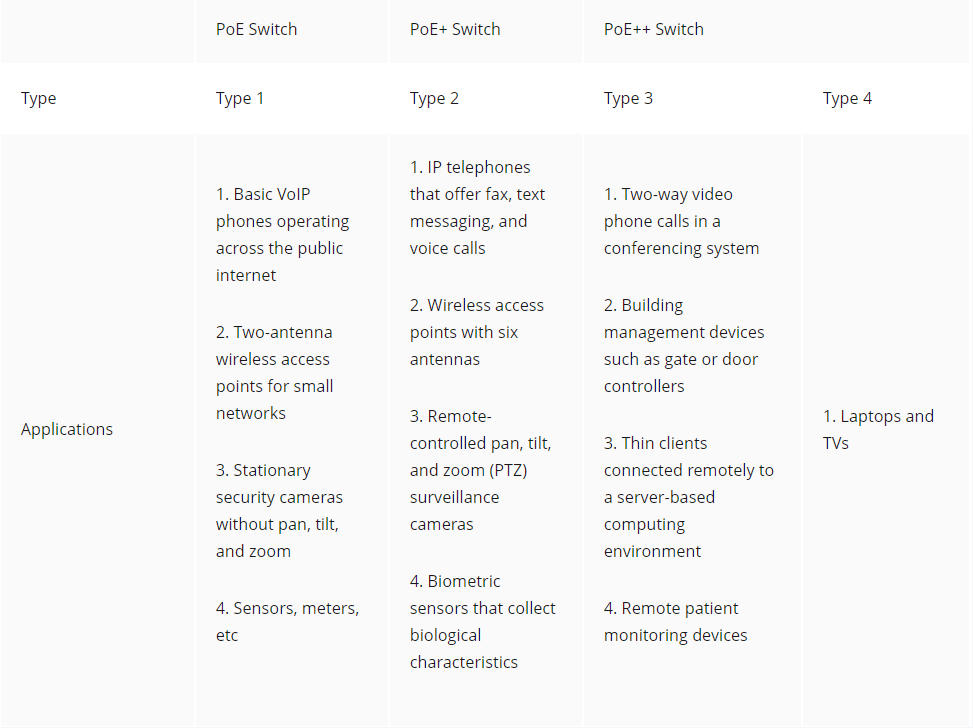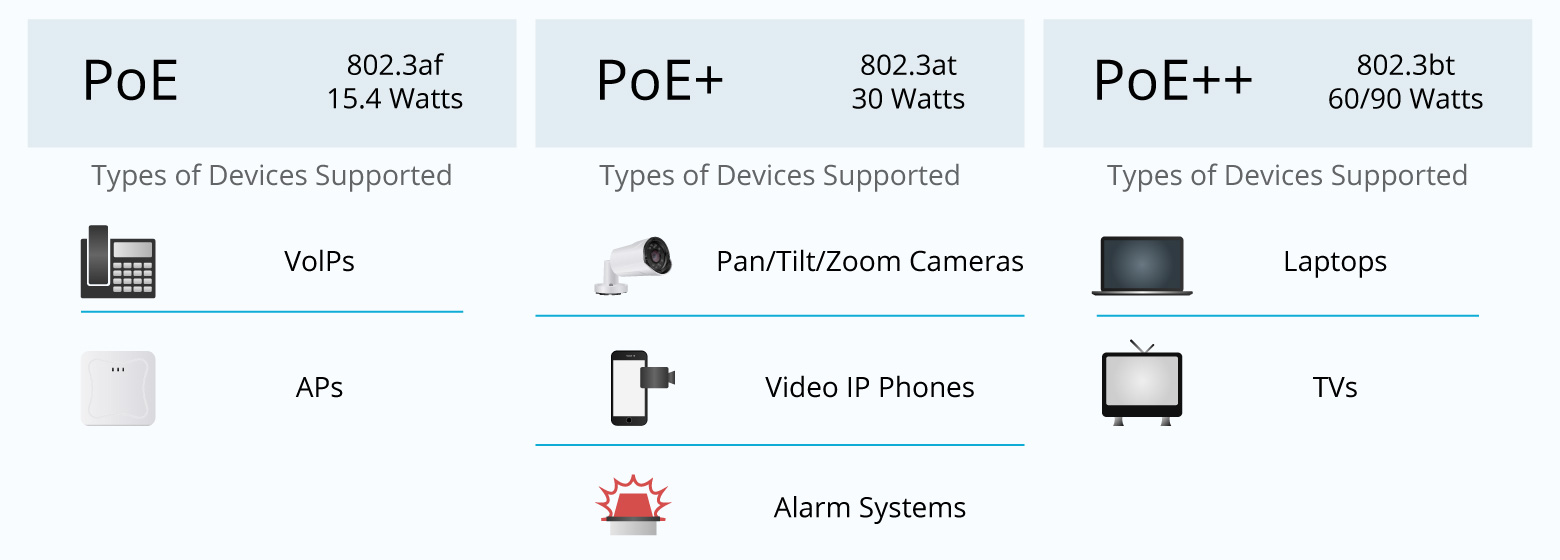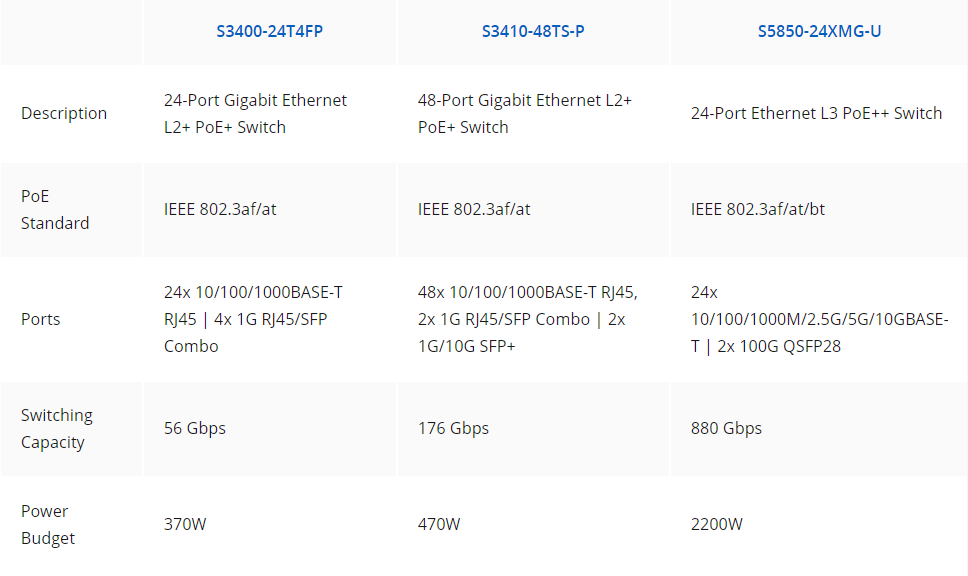PoE vs PoE+ vs PoE++ Switch: How to Choose?
2024-09-04 22:29:59
PoE vs PoE+ vs PoE++ Switch: How to Choose?
PoE, or Power over Ethernet, is a proven time-saving and money-saving technology that delivers data and power safely over the same Ethernet cable for the local area networks (LANs). In the current market, if you notice Power over Ethernet switch types, you will find that there are PoE switches, PoE+ switches, and PoE++ switches. But how much do you know about these three PoE switch types? This article sheds light on the differences between PoE vs PoE+ vs PoE++ switches as well as their applications. Hope this post will give you some inspiration on choosing a suitable PoE network switch.
Differences Between PoE vs. PoE+ vs. PoE++
Defined in 2003, Power over Ethernet (PoE) technology, under the IEEE 802.3af standard, initially allowed powered devices (PDs) such as VoIP phones to receive up to 12.95W of power using only two of the four twisted pairs in Ethernet cabling. By 2009, as devices began requiring more power, the IEEE 802.3at standard evolved into PoE+ technology, serving the increased wattage demands of gadgets like wireless access points that needed over 12.95W to function effectively.
To further accommodate the expanding needs of power consumption for a wider range of device applications, the IEEE 802.3 standard underwent another upgrade in 2018 to PoE++ (IEEE 802.3bt standard), introducing two types: Type 3, which delivers up to 51W of power using two or all four twisted pairs in a copper cable, and Type 4, which offers up to 71W over four twisted pairs in an Ethernet cable, marking a significant advancement in powering devices over Ethernet infrastructure.

What Is PoE Switch?
PoE switch refers to an application of PoE technology. Functioning as a kind of PSE (power sourcing equipment), a PoE switch can supply power to PDs via Ethernet cables to realize network connectivity. Generally, an 802.3af switch supports max power consumption of up to 15.4W per PoE port with a voltage range between 44V and 57V. And the voltage range of PDs, connected with the PoE switch, is from 37V to 57V.
What Is PoE+ Switch?
Similar to a PoE network switch, the PoE plus switch also supplies power over two pairs, but it adds an additional power class that is able to deliver power up to 25.5W for a PD with a voltage range from 42.5V to 57V. The max power delivered by each port of a PoE+ switch is 30W, along with a voltage range from 50V to 57V.
What Is PoE++ Switch?
PoE++ network switch is the next generation of PoE+ technology. PoE++ switch supports up to 60 watts of power to each port under Type 3 and offers the highest level of power for Power over Ethernet switches--up to 100W on each PoE port under Type 4.
PoE vs. PoE+ vs. PoE++ Switch: Which to Choose?
When selecting a PoE switch, it's crucial to base your choice on varying needs. This section provides information to help you make the best selection among four types of PoE switches, considering both specifications and applications.
Specifications of PoE vs. PoE+ vs. PoE++ Switch
Based on the above-mentioned introduction, a reference chart that summarizes detailed specifications among PoE vs PoE+ vs PoE++ switches is presented below.

Note: the presented figures are just valuable in theory, while the total power capacity of PoE series switches in the application will be oversubscribed with more ports for many devices using less than maximum power. For instance, if you have a switch with all PoE++ Type 4 ports, it does not mean you will use all of them at maximum load 24×7. Consequently, you need to calculate the power requirements for all the powered devices that you plan to connect to the switch and select corresponding patch cables for your PoE design.
Applications of PoE vs. PoE+ vs. PoE++ Switch
Evidently, the major differences among PoE vs. PoE+ vs. PoE++ switches lie in their working mode and power supply, which are reflected in their applications.

PoE switch is a good choice if low-standard power levels are enough for your data center. Otherwise, PoE+ or PoE++ switch is better when a more robust and high-performance network with multiple varied devices is required, without concerning port limitations. They are also wise choices for building infrastructures of higher requirements and upgrade planning. Certainly, you can retain the existing PoE network design if it is adequate and fits your demands.

The main features of the three PoE switches are shown below.

Conclusion
In conclusion, if you intend to supply power to devices that demand greater power or foresee the expansion of your network in the future, opting for a higher PoE standard (like PoE+ or PoE++) could prove advantageous. Nonetheless, it is crucial to confirm compatibility, evaluate the capabilities of your current infrastructure, and take into account your specific requirements before reaching a decision.
Previous:How to Understand RX/TX Power Range on SFP Modules?


